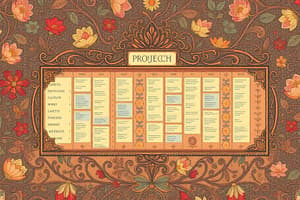Podcast
Questions and Answers
Which task involves creating initial versions of the product based on design specifications?
Which task involves creating initial versions of the product based on design specifications?
- Manufacture of prototype models (correct)
- Sales training
- Purchase of materials
- Revision of design
What is the purpose of conducting a preproduction advertising campaign?
What is the purpose of conducting a preproduction advertising campaign?
- To revise the product design
- To train staff on the new product
- To gather input on prototype models
- To generate interest before the product launch (correct)
Which task focuses on gathering insights from employees about the prototype?
Which task focuses on gathering insights from employees about the prototype?
- Initial production run
- Manufacture of prototype models
- Staff input on prototype models (correct)
- Post-redesign advertising campaign
Which option best describes the phase of testing and refining the product based on user feedback?
Which option best describes the phase of testing and refining the product based on user feedback?
What task is essential for preparing employees to effectively sell the product?
What task is essential for preparing employees to effectively sell the product?
What is the first task in the manufacturing milestone?
What is the first task in the manufacturing milestone?
Which task is focused on preparing staff for operational activities?
Which task is focused on preparing staff for operational activities?
Which of the following tasks is part of the advertising milestone?
Which of the following tasks is part of the advertising milestone?
Which task pertains to the initial phase of product preparation in the manufacturing milestone?
Which task pertains to the initial phase of product preparation in the manufacturing milestone?
Which task is applicable to the training milestone?
Which task is applicable to the training milestone?
What is the focus of the 'Staff input on prototype models' task?
What is the focus of the 'Staff input on prototype models' task?
What is the last task associated with the advertising milestone?
What is the last task associated with the advertising milestone?
Which task in manufacturing directly follows the purchase of materials?
Which task in manufacturing directly follows the purchase of materials?
What defines a Finish to Start (FS) relationship between two tasks?
What defines a Finish to Start (FS) relationship between two tasks?
Which of the following is an example of a Finish to Start (FS) relationship?
Which of the following is an example of a Finish to Start (FS) relationship?
What characterizes a Start to Start (SS) relationship?
What characterizes a Start to Start (SS) relationship?
Which of the following is a limitation of a Finish to Start (FS) dependency?
Which of the following is a limitation of a Finish to Start (FS) dependency?
Which example demonstrates a Start to Start (SS) relationship?
Which example demonstrates a Start to Start (SS) relationship?
In a Start to Start (SS) relationship, what is true about the activities?
In a Start to Start (SS) relationship, what is true about the activities?
Which statement is true about the Finish to Start (FS) dependency?
Which statement is true about the Finish to Start (FS) dependency?
What does parametric estimation rely on to estimate task durations?
What does parametric estimation rely on to estimate task durations?
What happens in a Start to Start (SS) scenario if the predecessor is delayed?
What happens in a Start to Start (SS) scenario if the predecessor is delayed?
What is the formula for calculating the expected value in the three-point estimation technique?
What is the formula for calculating the expected value in the three-point estimation technique?
What is the primary purpose of defining tasks and milestones in project management?
What is the primary purpose of defining tasks and milestones in project management?
Which of the following best defines project tasks?
Which of the following best defines project tasks?
What does the Work Breakdown Structure (WBS) primarily help to define?
What does the Work Breakdown Structure (WBS) primarily help to define?
In the context of project management, what do milestones signify?
In the context of project management, what do milestones signify?
What is the effect of having too many external task dependencies on project risk?
What is the effect of having too many external task dependencies on project risk?
Which type of dependency can affect the overall duration of a project?
Which type of dependency can affect the overall duration of a project?
What is the role of decomposition in project management?
What is the role of decomposition in project management?
Which of the following is NOT part of a task description?
Which of the following is NOT part of a task description?
What is represented by each descending level in the Work Breakdown Structure (WBS)?
What is represented by each descending level in the Work Breakdown Structure (WBS)?
In which basis is an example of WBS organized?
In which basis is an example of WBS organized?
What is typically included in the building a garage WBS's 'Roof Structure' section?
What is typically included in the building a garage WBS's 'Roof Structure' section?
Which component is fundamental to project planning and tracking?
Which component is fundamental to project planning and tracking?
Which of the following best describes a task in project management?
Which of the following best describes a task in project management?
What does Finish to Finish (FF) dependency entail?
What does Finish to Finish (FF) dependency entail?
Which of the following best describes a Start to Finish (SF) dependency?
Which of the following best describes a Start to Finish (SF) dependency?
Which of the following is an example of a Finish to Finish relationship?
Which of the following is an example of a Finish to Finish relationship?
What characterizes an Internal Dependency?
What characterizes an Internal Dependency?
What is a key limitation of the Finish to Finish (FF) dependency?
What is a key limitation of the Finish to Finish (FF) dependency?
Which of the following represents an example of an External Dependency?
Which of the following represents an example of an External Dependency?
In a Start to Finish (SF) dependency, which statement is true?
In a Start to Finish (SF) dependency, which statement is true?
What is indicated by the example 'arrival of doctors for a new shift → end of the shift'?
What is indicated by the example 'arrival of doctors for a new shift → end of the shift'?
Flashcards
Prototype Model Design
Prototype Model Design
Creating a sample of the product to test its design and functionality.
Purchase of Materials
Purchase of Materials
Buying the resources needed to build the product.
Manufacture of Prototype Models
Manufacture of Prototype Models
Building multiple examples of the product design.
Revision of Design
Revision of Design
Signup and view all the flashcards
Initial Production Run
Initial Production Run
Signup and view all the flashcards
Work Breakdown Structure (WBS)
Work Breakdown Structure (WBS)
Signup and view all the flashcards
Task Identification
Task Identification
Signup and view all the flashcards
Task Breakdown
Task Breakdown
Signup and view all the flashcards
Milestone
Milestone
Signup and view all the flashcards
Project Deliverables
Project Deliverables
Signup and view all the flashcards
WBS Example (Project Life Cycle)
WBS Example (Project Life Cycle)
Signup and view all the flashcards
WBS Example (Text Format)
WBS Example (Text Format)
Signup and view all the flashcards
Task Description
Task Description
Signup and view all the flashcards
Define Tasks and Milestones
Define Tasks and Milestones
Signup and view all the flashcards
Breakdown of Work
Breakdown of Work
Signup and view all the flashcards
Product Prototype
Product Prototype
Signup and view all the flashcards
Material Sourcing
Material Sourcing
Signup and view all the flashcards
Initial Production
Initial Production
Signup and view all the flashcards
Design Revision
Design Revision
Signup and view all the flashcards
Staff Training
Staff Training
Signup and view all the flashcards
Pre-production Advertising
Pre-production Advertising
Signup and view all the flashcards
Post-production Advertising
Post-production Advertising
Signup and view all the flashcards
Finish to Start (FS)
Finish to Start (FS)
Signup and view all the flashcards
Start to Start (SS)
Start to Start (SS)
Signup and view all the flashcards
What does 'Finish to Start' mean?
What does 'Finish to Start' mean?
Signup and view all the flashcards
What does 'Start to Start' mean?
What does 'Start to Start' mean?
Signup and view all the flashcards
Dependency
Dependency
Signup and view all the flashcards
Logical Dependency
Logical Dependency
Signup and view all the flashcards
Predecessor Task
Predecessor Task
Signup and view all the flashcards
Successor Task
Successor Task
Signup and view all the flashcards
Finish to Finish (FF)
Finish to Finish (FF)
Signup and view all the flashcards
Start to Finish (SF)
Start to Finish (SF)
Signup and view all the flashcards
Internal Dependency
Internal Dependency
Signup and view all the flashcards
External Dependency
External Dependency
Signup and view all the flashcards
What is a significant limitation of a Finish to Finish dependency?
What is a significant limitation of a Finish to Finish dependency?
Signup and view all the flashcards
What is a significant limitation of a Start to Finish dependency?
What is a significant limitation of a Start to Finish dependency?
Signup and view all the flashcards
What is an example of Finish to Finish dependency?
What is an example of Finish to Finish dependency?
Signup and view all the flashcards
What is an example of Start to Finish dependency?
What is an example of Start to Finish dependency?
Signup and view all the flashcards
Time Value of Money
Time Value of Money
Signup and view all the flashcards
Parametric Estimation
Parametric Estimation
Signup and view all the flashcards
Three-Point Estimation
Three-Point Estimation
Signup and view all the flashcards
Discretionary Dependency
Discretionary Dependency
Signup and view all the flashcards
External Task Dependency
External Task Dependency
Signup and view all the flashcards
Study Notes
PMGT3623 Scheduling
- The course covers scheduling, course resources, and assessment components
- Week 2 focuses on defining and sequencing project tasks
- Week 2 topics include: defining tasks and milestones, sequencing tasks, finish-to-start, start-to-start, start-to-finish, finish-to-finish, external vs internal dependencies, mandatory vs discretionary dependencies, and lead/lag time estimations
- A Work Breakdown Structure (WBS) is a deliverable-oriented grouping of project elements, organizing and defining the total scope of the project
- Each descending level of a WBS represents an increasingly detailed definition of the project work
- Milestones are specific moments with a definitive deliverable, while tasks are the efforts needed to reach those milestones
- Tasks are broken down into smaller components (work packages) to manage the overall project scope
- Tasks include details like objectives, deliverables, resources
- Defining milestones involves identifying critical points in the project timeline signifying the completion of major deliverables or phases
- Defining milestone criteria specifies what must be achieved for the milestone to be considered complete
- This helps to monitor progress and ensure alignment with project goals
- Examples of 'define task and milestone' include designing, manufacturing, and marketing a palm book computer, as well as building a garage.
- Sequencing in project management is arranging project tasks in a specific order. It involves organizing and prioritizing tasks logically to ensure smooth execution and successful completion
- This is vital for meeting deadlines and achieving project goals efficiently
- Visualization tools like network diagrams are used to demonstrate task order and dependencies
- Logical dependencies between tasks include Finish-to-Start (FS), Start-to-Start (SS), Finish-to-Finish (FF) and Start-to-Finish (SF)
- External dependencies relate to tasks in different projects, requiring approvals from external parties
- Internal dependencies concern tasks within the same project
- Mandatory dependencies are required by contract, law, or best practices, while discretionary dependencies could lead to financial benefits
- Project risk increases with the number of external task dependencies affecting project completion time and cost
- Discretionary dependencies can impact project duration as decisions are made during the project
Task Dependency and Project Risk
- A diagram illustrates the relationship between task dependencies and project risk, showing increasing risk with more mandatory dependencies and external dependencies
- External dependencies increase inherent risk more than discretionary dependencies
Estimate Task Duration (Discrete Approach) – Part C
- Two primary steps for estimating task duration:
- Historical Data Analysis: Review historical data from similar tasks or projects to estimate the duration of the current task
- Expert Judgment: Use experts with experience in similar projects to refine/adjust estimates if historical data is not available
Estimation Techniques
- Analogous Estimation: Assumes the current project will cost the same as a similar past project, adjusting for differences in scope, complexity
- Parametric Estimation: Uses statistical relationships between historical data and variables like the number of units produced per hour
- Example: If producing 10 units takes 2 hours, producing 20 units will take 4 hours
- Three-Point Estimation: Uses three estimates to derive an average duration or cost for an activity
- Example formula: Expected value = (0 + 4M + P) / 6
Review Questions
- Define project tasks and milestones
- Project tasks are the individual work efforts to achieve a project goal while milestones are major events that mark significant progress and completion of phases.
- What are lead and lag times? How are they related to project scheduling?
- Lead time is the time a dependent activity starts before its predecessor is finished, used for Finish-to-Start (FS) dependencies to reduce scheduling time. Lag time is the idle wait time between activities and is added to overall time, used for all types of dependencies.
- What are the differences between discretionary and mandatory dependencies? What are the four different types of logical dependencies between two tasks?
- Mandatory dependencies are required by contract, law, or best practices, whereas discretionary dependencies are optional and can lead to benefits. The four logical dependencies are FS, SS, FF, and SF.
- What are the steps in estimating the duration of a task?
- This includes reviewing historical data from similar projects and using expert judgment for unavailable historical data.
- What is the impact of having too many external task dependencies on project risk?
- Having too many external task dependencies increases project risk in terms of project completion time/cost. External dependencies are often less controllable than internal/discretionary dependencies.
- Does the discretionary dependency impact project duration?
- Discretionary dependency can impact project duration. It may lead to projects taking more or less time than projected with potential cost implications.
Studying That Suits You
Use AI to generate personalized quizzes and flashcards to suit your learning preferences.




